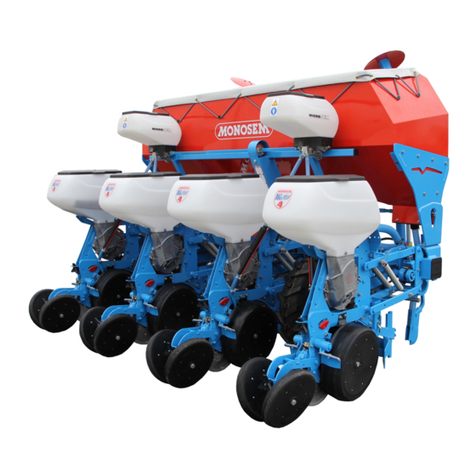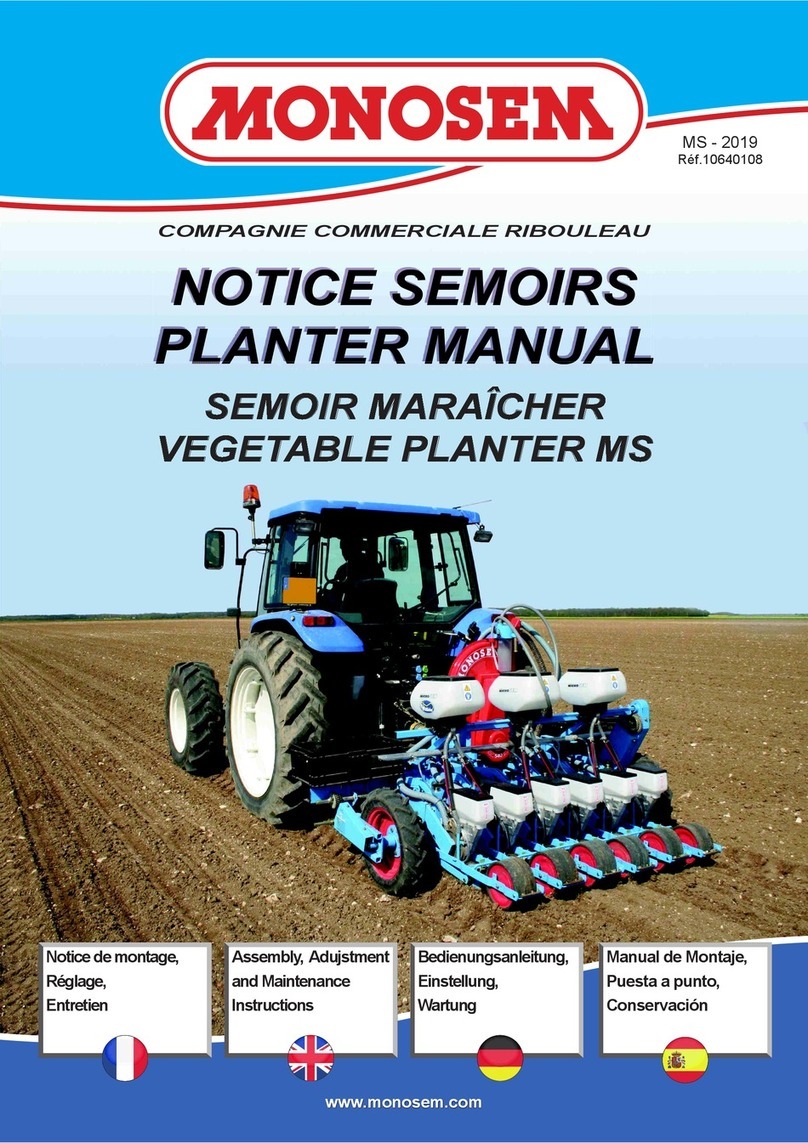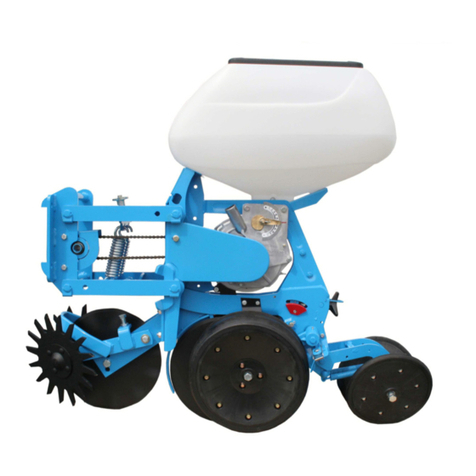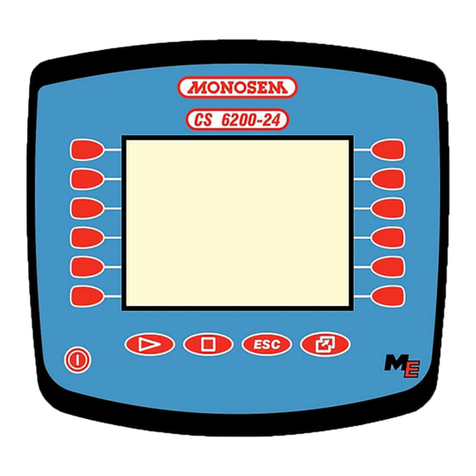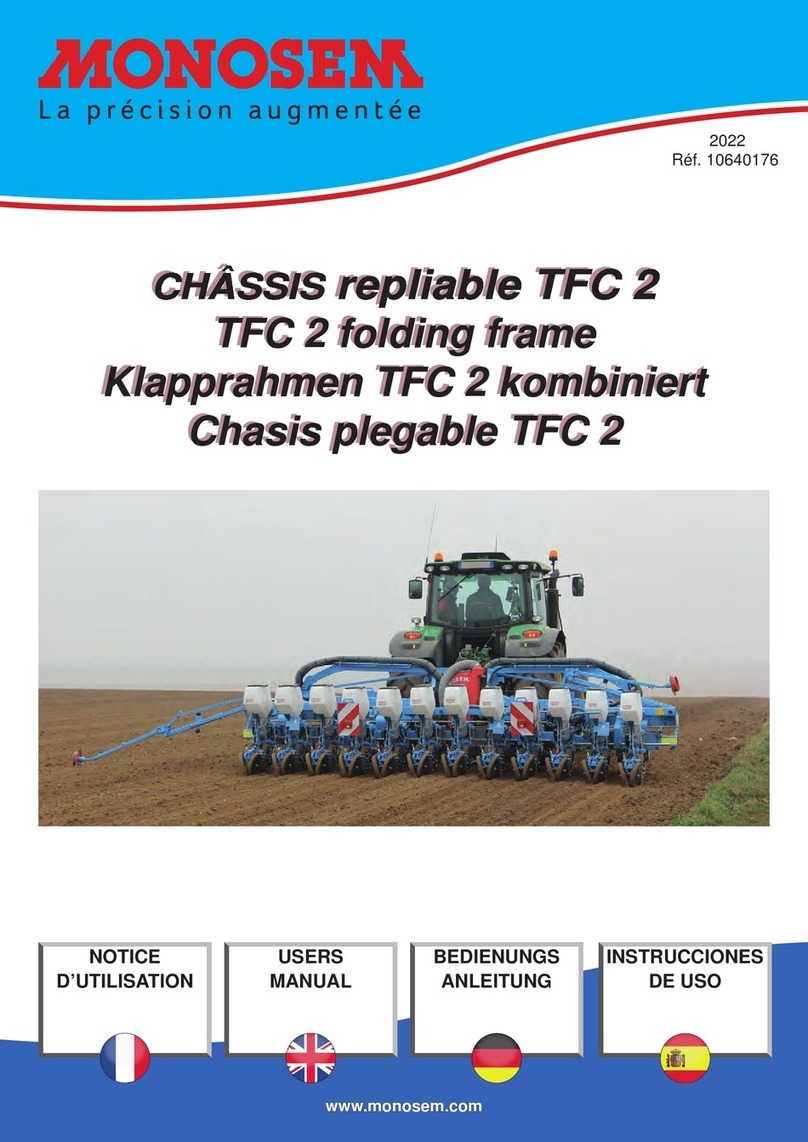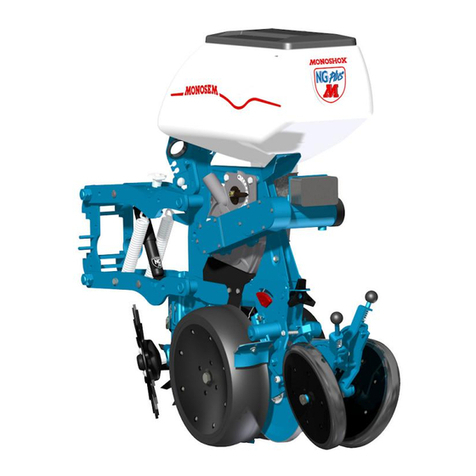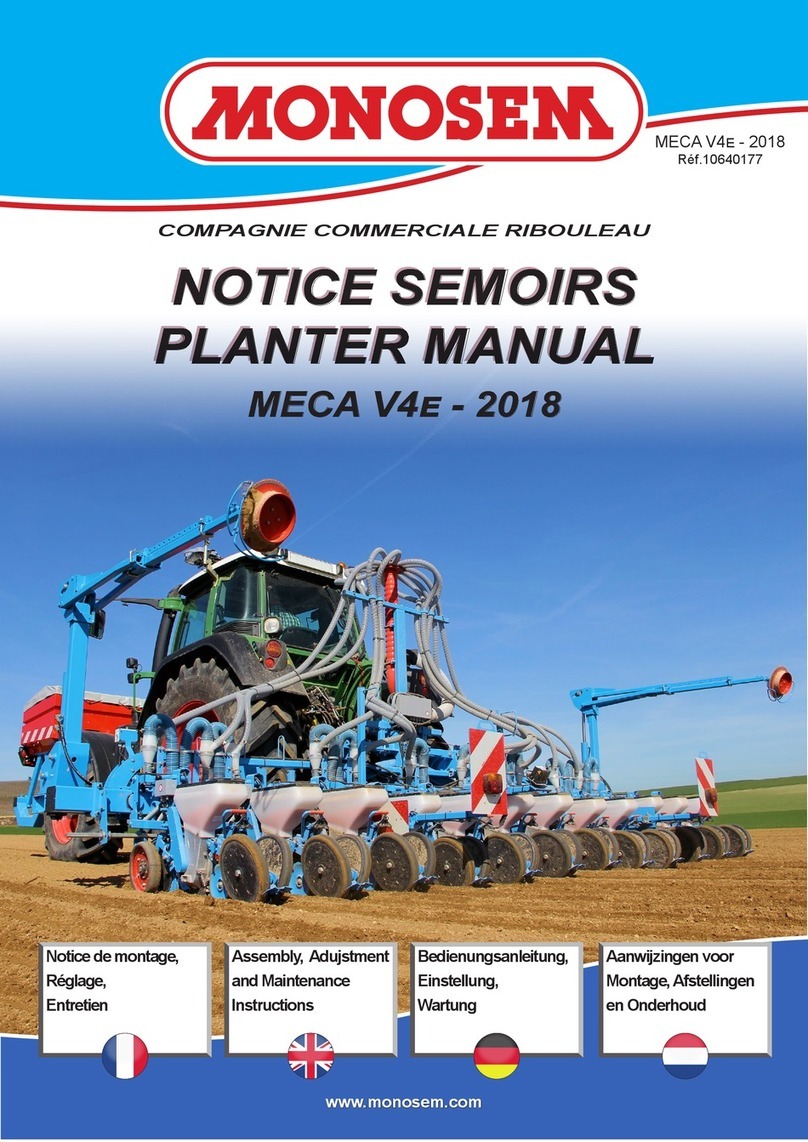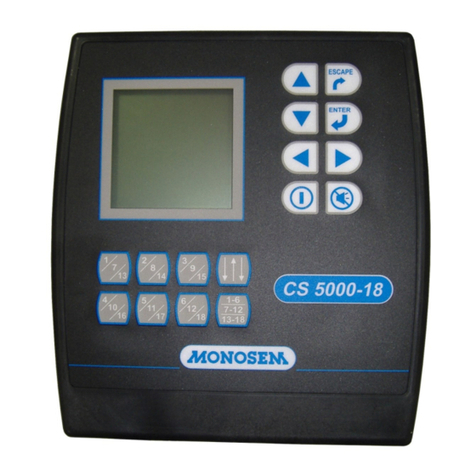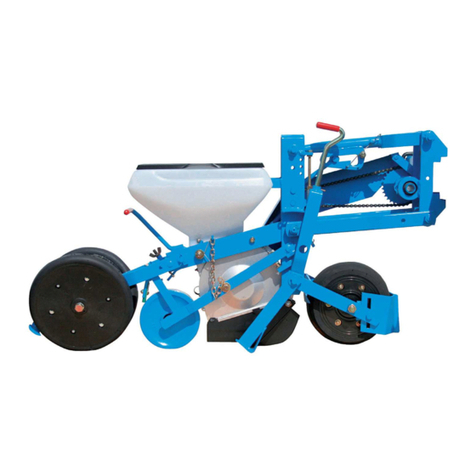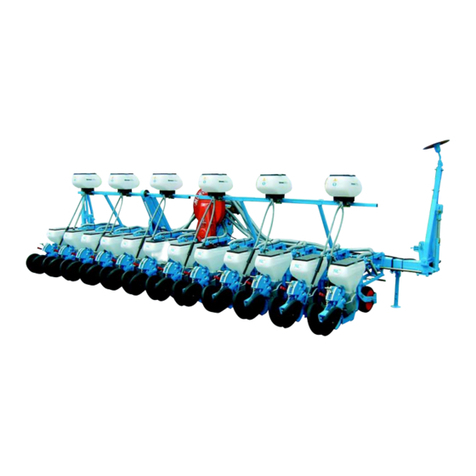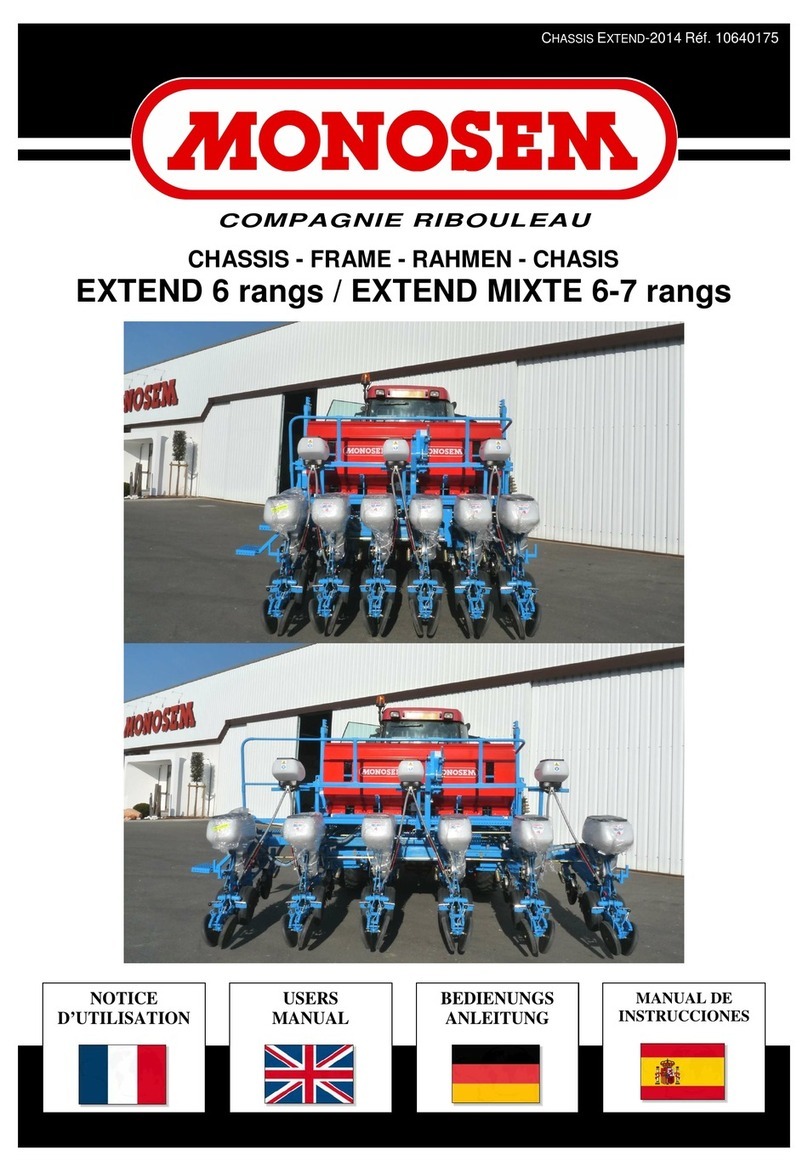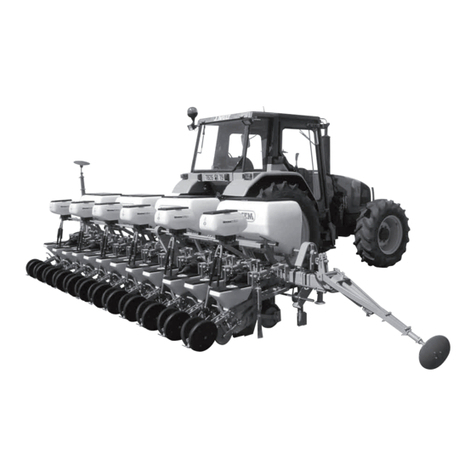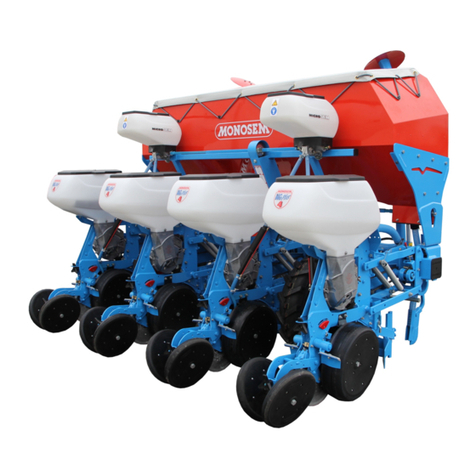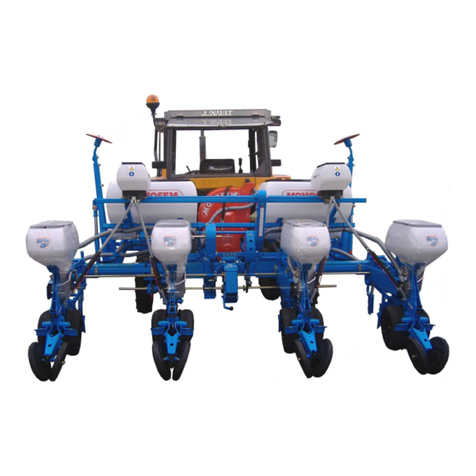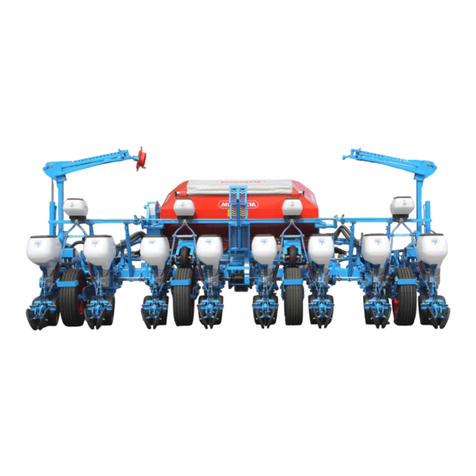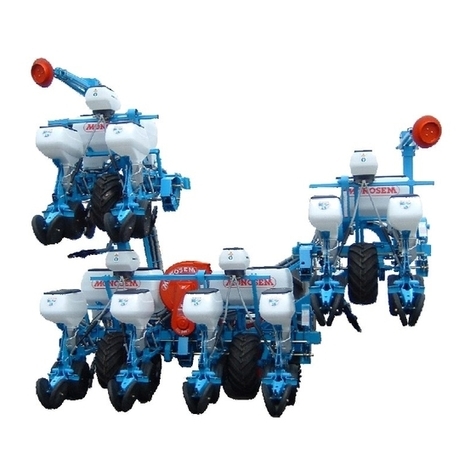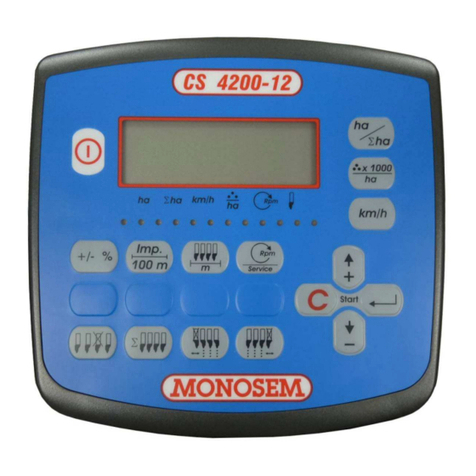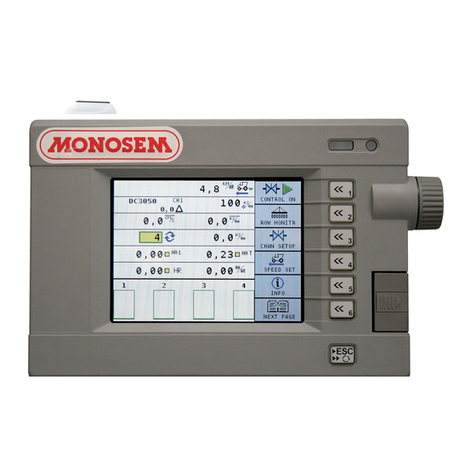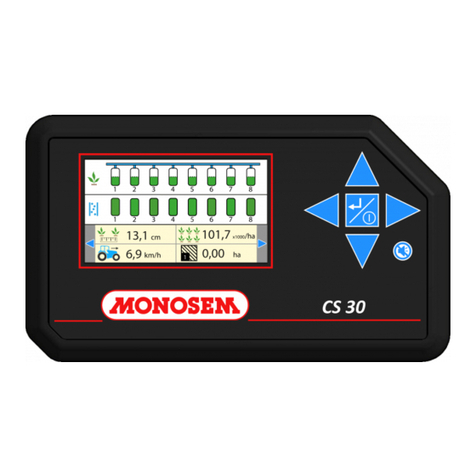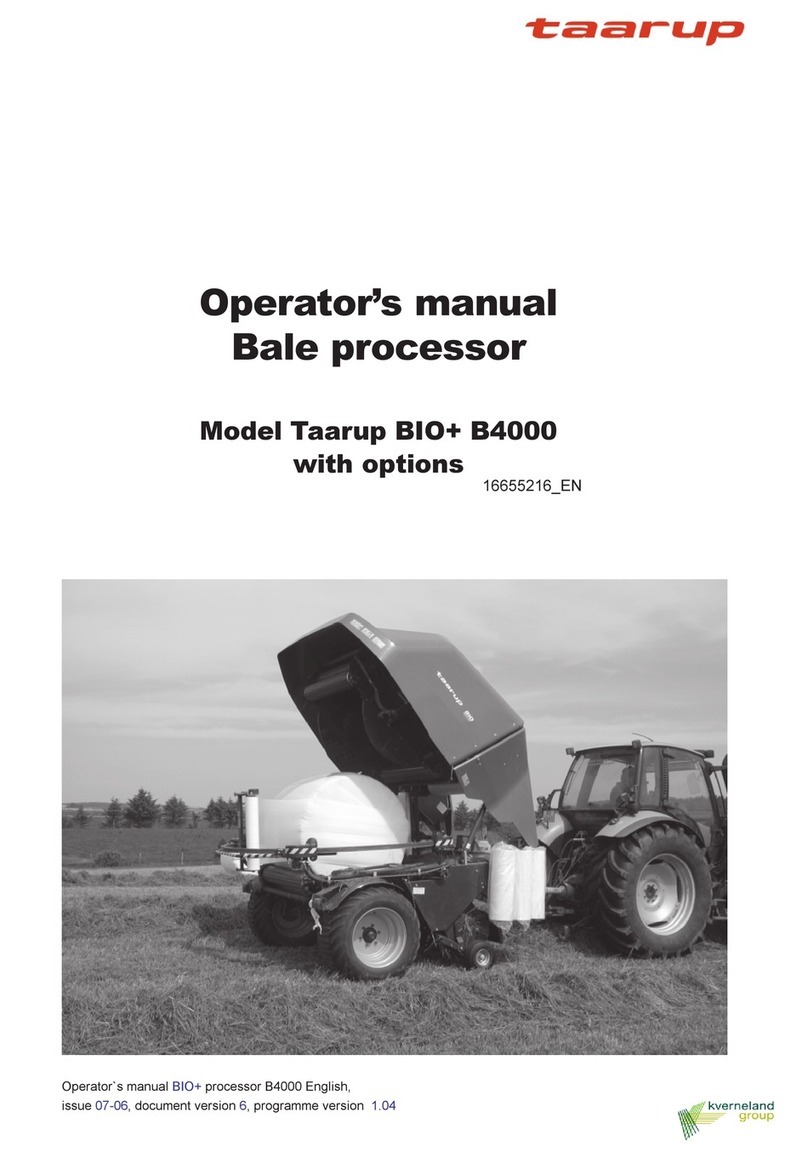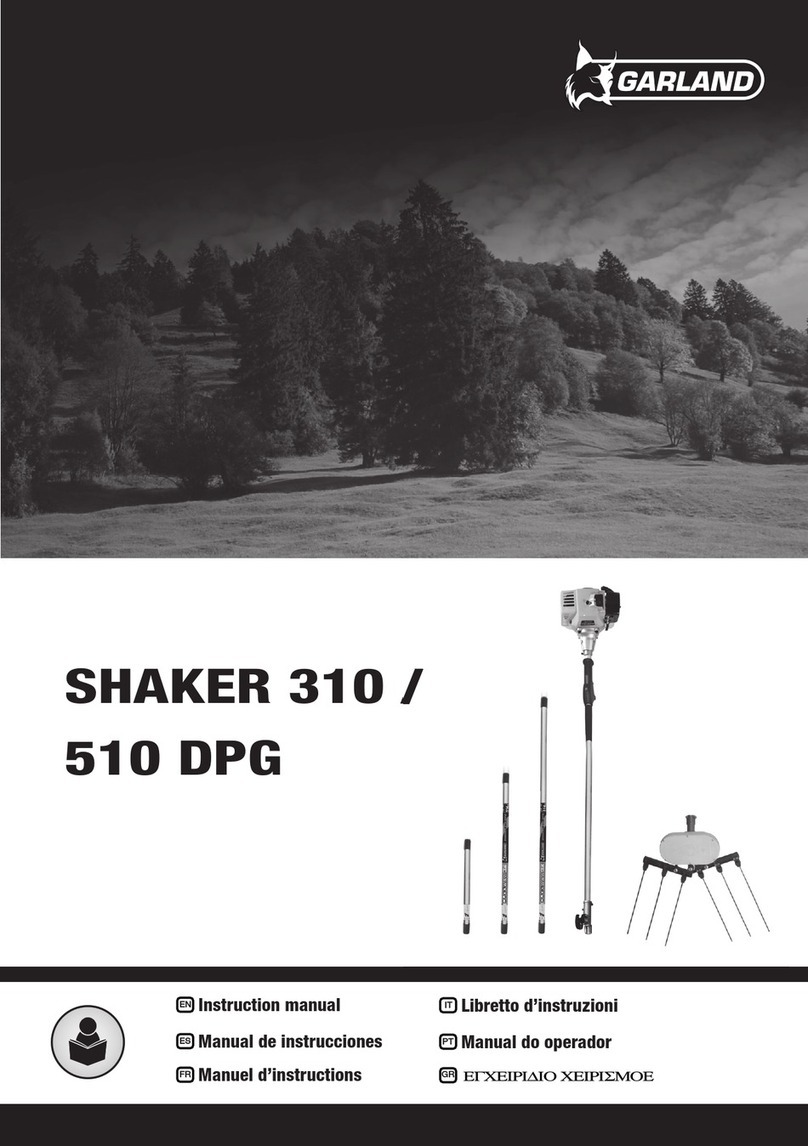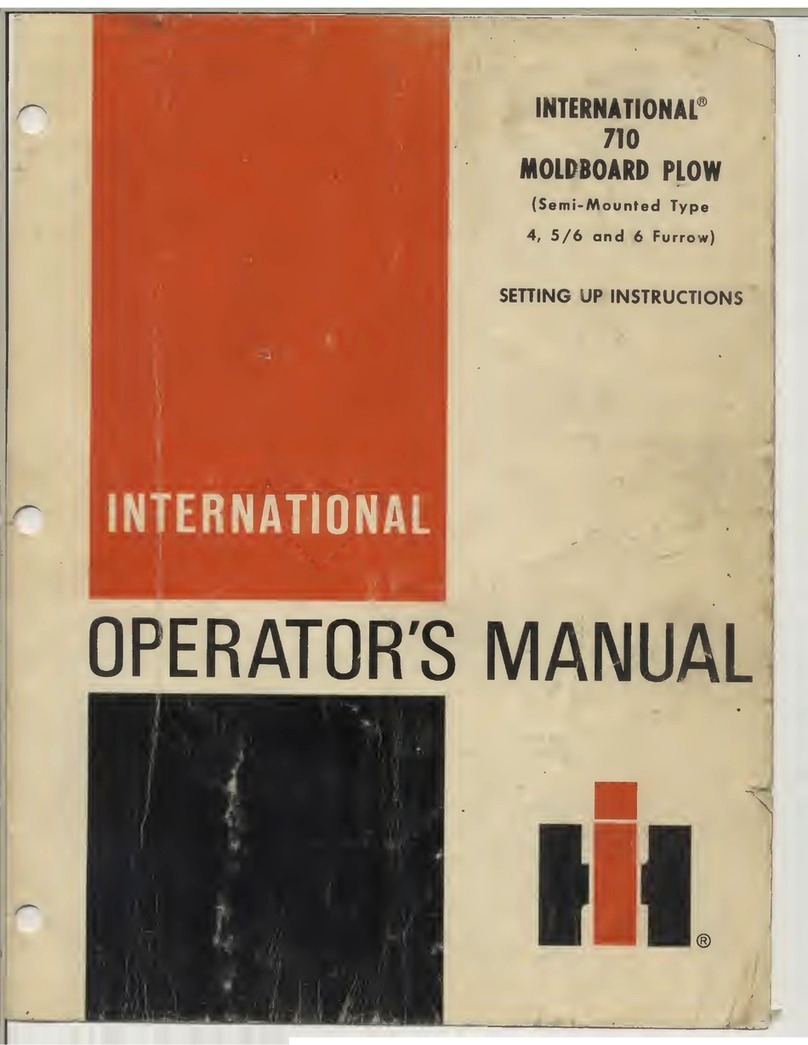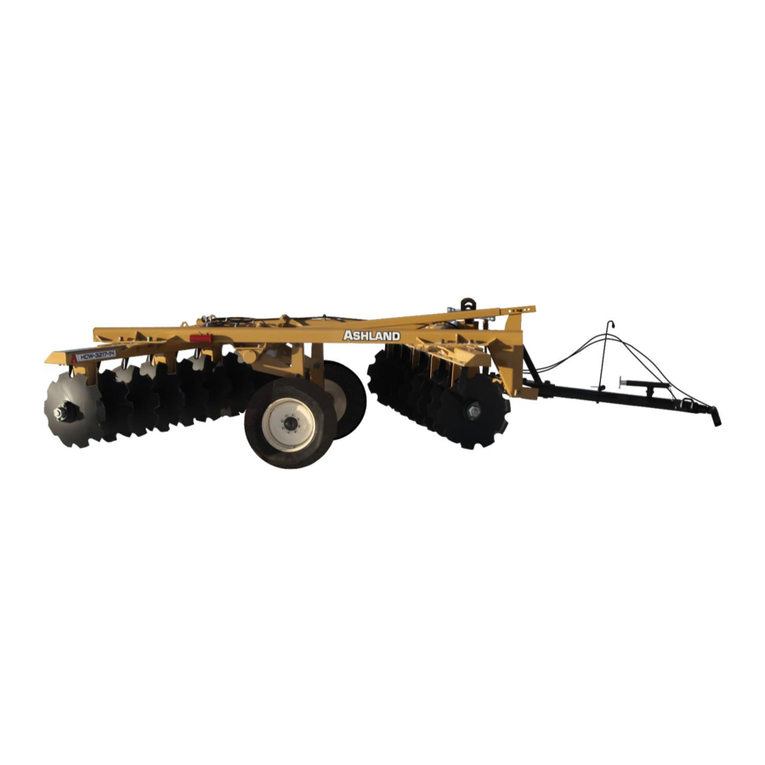419
MONTAGE GÉNÉRAL
Châssis monobarres 6 – 12 rangs (fig. 1 et 2)
– Placer la barre porte-outils sur 2 supports puis repérer les emplacements des blocs roues et des éléments.
– Mettre en place les blocs roues – la ou les béquilles (fig. 7) - la boîte de distances (fig. 4) - l’attelage (fig. 5)
avec ses tirants - les éléments semeurs (voir page 6).
– Enfiler les axes hexagonaux
➀
et
➁
, les équiper au passage des pignons de boîte de distances, et du
pignon de Microsem (page 10).
– Monter la chaîne de boîte de distances, vérifier le tendeur
➂
et son taquet d’accrochage
➃
.
– Monter les ensembles rayonneurs :
• Modèle manuel (fig. 12) avec inverseur et guide-cordes (fig. 14).
• Modèle hydraulique livré en option pour châssis 6 rangs de 3 m (fig. 13).
• Modèle hydraulique livré de série pour châssis 12 rangs de 6,10 m (fig. 16).
• Modèle hydraulique repliable pour châssis grande largeur (fig. 17).
A noter le blocage en position transport par la bague
➄
ou les broches
➅
.
– Procéder à un graissage général, atteler au tracteur et vérifier : le relevage du semoir – les diverses
transmissions – l’efficacité des tendeurs, la rotation de leur galet – la manœuvre des rayonneurs par la
vanne
➆
(à brancher suivant fig. 15 à l’extérieur de la cabine du tracteur).
Châssis couplés 12 – 18 rangs
Même ordre de montage que ci-dessus pour chacun des 2 semoirs.
L’écartement des pièces d’accouplement dépendra de l’inter-rangs à réaliser, toutes les possibilités sont
permises.
Remarques importantes
– Retendre les chaînes de blocs roues, après montage, par le tendeur fig. 8 (vers le haut).
– L’axe hexagonal inférieur
➀
se bloque en position par les 2 vis des paliers de blocs roues (fig. 9).
– L’axe hexagonal supérieur
➁
se bloque en position par les vis des 2 bagues
➉
(fig. 10).
– L’attelage 3 points peut se monter en déport (fig. 6) avec 1 seul tirant.
– Les brides latérales d’attelage standard acceptent des axes n° 1 ou 2.
– Un attelage semi-automatique est adaptable en option sur le châssis 6 rangs (fig. 5).
– Des supports paliers
➇
seront à utiliser dans le cas d’inter-rangs supérieurs à 50 cm.
– Chaque vérin possède au niveau de son raccord 11 une bague de ralenti avec trou réduisant le passage
d’huile. L’encrassement de cette bague ou le bouchage de son trou par des impuretés seront la cause du
mauvais fonctionnement du vérin et des rayonneurs. En cas de démontage pour nettoyage replacer avec soin
la bague dans sa position initiale.
APRÈS QUELQUES HEURES DE TRAVAIL, LE BLOCAGE DES BRIDES D’ATTELAGE SERA A CONTRÔLER.
ALLGEMEINE MONTAGE
Einzelrahmen 6 – 12 reihig (Abb. 1 und 2)
– Den Werkzeugrahmen auf 2 Halterungen setzen, dann die Radhalter – und Säelementestellungen
markieren.
– Radhalter anschrauben – Stütze(n) (Abb. 7) – das Wechselgetriebe für die Pflanzenabstände - (Abb. 4) das
Dreipunktgestänge mit Verbindungsstangen – die Säelemente (siehe Seite 6) anschrauben.
– Die Sechskantachsen
➀
und
➁
einführen und sie gleichzeitig mit den Zahnrädern des Wechselgetriebes,
und dem Zahnrad von Microsem (Seite 10) ausrüsten.
– Die Kette des Getriekeastens einsetzen, den Spanner
➂
und den Feststeller für den Kettenspanner
➃
überprüfen.
– Die Spuranzeiger montieren :
• Modell für Handbetätigung (Abb. 12) mit Markörbedienung und Seihalter (Abb. 14).
• Modell für Hydraulische Betätigung als Sonderausrüstung für 6-reihigen 3 m Rahmen (Abb. 13).
• Modell für hydraulische Betätigung serienmässig ausgerüstet für 12-reihigen Rahmen 6,10 m (Abb. 16).
• Hydraulisch klappbares Modell für große Rahmen (Abb. 17).
Verriegelung in der Transportstellung erfolgt durch den Ring
➄
oder Stifte
➅
.
– Vor Beginn der Arbeit ist die Sämaschine völlig abzuschmieren. An den Schlepper anbauen und das
Ausheben der Sämaschine – die verschiedenen Antriebe – die Leistung der Spanner, die drehende
Bewegung der Rollen – die Betätigung der Spuranzeiger durch das Ventil
➆
(Abreisskupplung je nach
Abb. 15) überprüfen.
12-18 reihige Doppelrahmen
Gleiche Montagereihenfolge wie oben für die beiden Sämaschinen.
Der Abstand der Kupplungsstücke wird vom zu pflanzenden Reihenabstand abhängen. Alle Reihenabstände
sind möglich.
Wichtige Hinweise
– Nach der Montage sind die Ketten an den Radhaltern mit dem Spanner 8 zu spannen.
– Die untere Sechskantwelle
➀
wird durch die Schrauben die an den Lagern der Radhalter befestigt sind (Abb. 9),
– blockiert.
– Die obere Sechskantwelle
➁
wird durch die zwei Feststellringe
➉
– Abb. 10 – blockiert.
– Das Dreipunktgestänge kann seitlich verschoben werden (Abb. 6), evt. nur eine Stabilisierungsstange montieren.
– Die Maschine kann mit Kat. 1 und Kat. 2 – Anbaubolzen geliefert werden.
– Ein Schnellkuppler kann auf Wunsch an eine 6-reihige Maschine montiert werden. (Abb. 5)
– Die lagerhalter
➇
werden montiert bei Reihenweite über 50 cm.
– Jeder Zylinder ist mit einer Senkdrossel ausgerüstet, die in der Verschraubung 11 montiert ist. Bei schlechter
Funktion der Spuranzeiger kann die Drossel verstopft sein. Nach Reinigung der Drossel, sollte diese wieder
genau in gleicher Stellung eingebaut werden.
NACH EINIGEN BETRIEBSSTUNDEN SOLLEN SÄMTLICHE SCHRAUBEN AM DREIPUNKTGESTÄNGE
NACHGEZOGEN WERDEN.
ОАЯ ОА
ельная рама 6 - 12 рядов (стр. 1, 2)
–оместите раму на две сборочных подставки, затем мелом начертите различные положения ведущих колес и высевающих
секций.
–рисоедините ведущие колеса, подставки сеялки (рис. 7), коробку передач точного высева (рис. 4), трехточечное навесное
устройство (рис. 5) с его растяжками, высевающие секции (см. стр. 6).
–ставьте шестигранные валы
➀
и
➁
,через блок звездочек коробки передач и блок звездочек системы икросем
(см. стр. 10).
–акрепите цепь центральной коробки передач точного высева, проверьте натяжитель цепи
➂
и его блокировочный замок
➃ (рис.4).
–рисоедините рядные маркеры:
• учная модель (рис. 12) с реверсивным устройством и направляющими (рис. 14).
• идравлическая модель, поставляемая по дополнительному заказу, для 3 м 6-рядной рамы (рис. 13).
• идравлическая модель, поставляемая в стандартной комплектации, для 6,1 м 12-рядной рамы (рис. 16).
• идравлическая выдвигающаяся модель для рам широкозахватных сеялок (рис. 17).
ледует отметить, что блокировка маркера в верхней позиции для транспортировки обеспечивается стопорным кольцом
➄
либо стопорными штырями
➅
.
–мажьте все необходимые места, присоедините сеялку к трактору и проверьте: хорошо ли поднимается сеялка,
вращение приводных колес, натяжение цепи и вращение роликов цепи, поднятие рядных маркеров при помощи клапана
➆
(он должен быть подключен, как показано на рис. 15).
борные 12-18-рядные рамы
орядок сборки такой же, как и для предыдущих двух сеялок.
азмеры соединительных частей зависят от междурядных интервалов. озможен большой выбор.
ажные примечания
– осле сборки заново затяните гайки натяжителей цепей ведущих колес (рис. 8 выше).
– оложение нижнего шестигранного вала
➀
блокируется болтами крепления блоков ведущих колес (рис. 9).
– оложение верхнего шестигранного вала блокируется двумя стопорными болтами втулок
➉
(рис. 10).
– рехточечное навесное устройство может быть установлено со сдвигом (рис. 6) при помощи только одной растяжки.
– тыри навесного устройства 1 или 2 могут быть расположены на нижних кронштейнах.
– ополнительная полуавтоматическая сцепка может быть использована на 6-рядной раме (рис. 5).
– репления
➇
следует использовать для посева при междурядных интервалах, превышающих 50 см.
– аждый цилиндр имеет дроссельное устройство, расположенное на крепежном соединении 11 , с отверстием для
уменьшения расхода масла. асорение или закупоривание отверстия дросселя посторонними телами может послужить
причиной плохой работы цилиндра и рядных маркеров. случае снятия дросселя в целях чистки аккуратно установите его в
первоначальное положение.
О ОЬ АО АО ОЬ АЯУ ЭО.
GENERAL ASSEMBLY
Single bar 6 – 12 row frame (fig. 1 + 2)
– Place the toolbar frame upon 2 assembly jacks then chalk the different positions of the drive wheels and
metering units.
– Attach the drive wheels – the planter jack(s) (fig. 7) – the spacing gearbox (fig. 4) – the 3 point hitch (fg. 5)
with its tiebraces – the metering units (see page 6).
– Slide the hexagonal shafts
➀
and
➁
, during this action through the gearbox sprockets, and Microsem
sprocket (page 10).
– Fix the chain of the central spacing gearbox, check the chain tightener
➂
and its locking pawl
➃
.
– Attache the row markers :
• Manual model (fig. 12) with reversing device and line guides (fig. 14).
• Hydraulic model supplied optionally for 3 m 6 rows frame (fig. 13).
• Hydraulic model, standard supplied for 6,10 m 12 rows frame (fig.16).
• Hydraulic folding mode for wide configuration frames (fig. 17).
It should be noted that locking in upright position is provided either by lockring
➄
or lock pins
➅
for transport.
– Proceed to overall lubrication, hitch the planter to the tractor and check : if planter lifts easily – the various
transmissions – the efficiency of the chain tighteners and rotation of their rollers – operation of the row
markers by the valve
➆
(to be connected as per fig. 15).
Coupled frames 12 – 18 row
Same assembly order as above for both planters.
Spacing of the coupling parts will depend on the inter-row spacing. Possibility of large variations.
Important notes
– After assembly retighten the chains of the drive wheel blocks, by the tightener fig. 9 (upwards).
– The lower hexagonal shaft
➀
is locked in position with the bolts of the bearings of the drive wheel blocks
(fig. 9).
– The upper hexagonal shaft
➁
is locked in position with the bolts of the 2 bushing stops
➉
(fig. 10).
– The 3 point linkage can be offset mounted (fig. 6) with 1 tiebrace only.
– The lower hitch brackets can accommodate the cat 1 or 2 hitch pins.
– An optional semi-automatic hitch can be used on the 6 row frame (fig. 5).
– The bearings
➇
are to be used when planting at inter-rows of over 50 cm.
– Each cylinder has a flow restrictor ring at the fitting connection 11 with a hole to reduce oil flow. Dirt
accumulation of this ring or clogging-up of its hole by foreign matters will be the cause of the bad operation of
the cylinder and the row markers. In case of disassembly for cleaning purposes, replace the ring carefully in its
intial position.
AFTER A FEW HOURS’OPERATION, CHECK THE MOUNTING BRACKETS FOR TIGHTNESS.
Rép. Désignation
1339 Bague d'articulation (B11)
1829 Ressort de manette
4329 a Circlip I42
4503 Ecrou frein ø 16
4584 Boule de manœuvre
5019 a Ressort de couvercle
5021 Bague autolubrifiante (B25)
5064.b Brosse
5346 Ressort de tête
5347 Volant de débrayage
5633 a 1/2 roue arrière fonte
5635 a Tube axe de rour concave
5638.2 Décrottoir Green flex arrière
5653 Ressort d'accochage tendeur
5671 Support décrottoir arrière
5672 Contre plaque
5681 b Ressort de décrottoir
5687 Boulon axe de roue concave
5691 Axe de décrottoir roulette
5692 Ecrou papillon ø 10
6081 a Ressort (R133)
6090 Circlip d'arrêt ø 6
6213 Circlip E20
6221 Roulement 6004 2RS
6250 Corps de boîtier Méca 3
6251 Axe central de boîtier
6253 Séparateur intérieur
6253.1 Séparateur intérieur (endive enrobée)
6255 Entretoise de roulements
6256 plaque serre film
6257 Film plastique
6258 Plaque de protection basse
6259 Pignon de boîtier
6260 a Trémie plastique
6261 Couvercle de témie
6262 Disuqe : préciser référence : 5,5 A5 - 5,7 A5…
6264 Trappe de vidange
6265 Entretoise pour carter
6266 b Patte orientable
6267 Axe de galet fixe
6268 Bras de paraléllogramme inférieur
6269.1 Bras de paraléllogramme supérieur (débrayage électrique)
6270 Axe inférieur de taquet
6271 Axe bras inférieur de paraléllogramme
6272 Tendeur de chaîne
6273 Galet tendeur
6274 Bague autolurifiante
6275 b Corps d'élément betterave
6276 Pointe de soc seule standard
6276.1 Pointe de soc seule spéciale fuyante
6277 a Soc complet standard
6277.1a Soc complet spécial fuyant (option)
6278 Porte écrous de fixation séparateur
6279 Axe bras supérieur de paraléllogramme
6280 b Fourche de roue avant
6280.1 Bloc avant porte disques et roues
6281 a Axe réglage terrage
Rép. Désignation
6285 Ressort de bloc tasseur
6286 Entretoise de béquille
6287 Béquille d'élément
6288 Axe de béquille et fourche
6290 b Bras de roulette intermédiaire
6290.1b Bras de roulette intermédiaire long
6291 Chaîne de roulette intermédiaire
6292 b Bloc arrière pour roues inclinées (l = 495)
6292.1a Bloc arrière long (l = 545) GB et ponctuel
6292.2a Bloc arrière long (l = 585)
6294 a Bras de roto herse long
6295 a Bras de roto herse court
6296 Bloc arrière pour roue concave
6296.1 Bloc arrière pour roue concave avec ponctuel
6297.1 Pignon de tête d'élément
6299 Moyeu de tête d'élément
6300 Axe amovible
6301 a Carter de chaîne supérieur
6302 Carte de chaîne inférieur
6304 Décrottoir de roues arrires 300 x 40
6305 D Descente Micro insecticide de côté D
6305 G Descente Micro insecticide de côte G
6306 Décrottoir de roue avant
6307 Raclette latérale (option)
6307.1 Raclette latérale lourde (option)
6308 Vis à oreilles de réglage
6309 a Bague de raclette
6310 Vis de réglage bras de roto herse
6311 Ressort de maintien carter
6313 Ecrou flottant (option balancier)
6314 Tige de réglage
6316 a Bras de renvoi arrière
6317 Entretoise
6318 Arrêt de vis de terrage
6319 Palier de réglage
6320 Ecrou à oreilles ø 12
6375 Carter protège disque
6399 Tige filetée de roulette intermédiaire
6763 a Bandage souple autonettoyant
6771 Roto herse
6772 Bague autolubrifiante
6773 Cuvette roto herse
6779 Bague autolubrifiante
6789 a Roulette avec bandage étroit (option)
6789.1 Bandage souple seul étroit
6789.2a Jante fonte seule pour bandage étroit
6790 a Décrottoir roulette (Green flex)
6791 a Support décrottoir
6792 a Support fixe de décrottoir
6795 Ecrou papillon ø 8
6796 Plaquette pour décrottoir
6915 Circlip E30
6954 Roue farmflex ø 260 x 100 complète
6954.1 1/2 jante seule
6954.2 Pneu seul
6963 Axe avant inférieur de paraléllogramme
6965 Axe avant supérieur de paraléllogramme
Rép. Désignation
6967.5 Cadre de tête Méca 2000
6968.1 Boulon complet de cadre
6969 Contre-bride de tête d'élément
6972.3 Tête débrayable avec sécurité
6998 Ressort bloc avant à disques
7009.3 Disque seul (sans moyeu) pour montage avec pneu
7009.4 Disque avec moyeu pour montage avec pneu
7010 a Moyeu de disque seul
7012 Ga Axe de roulement disque côté gauche
7012 Da Axe de roulement disque côté droit
7014 a Roulement de disque réf. 3204
7015 a Rondelle d'étanchéité réf. 6204 ID
7016 D Décrottoir droit
7016 G Décrottoir gauche
7017 b Support décrottoirs extérieurs
7018.3 Décrottoir extérieur pour disque avec pneu
7020 1/2 pneu pour disque
7021 Jante de 1/2 pneu
7044 Rondelle caoutchouc, roue concave
7071 Tige filetée de réglage
7083 Volant de terrage (option)
7091 Goupille beta de carter
7091.1 Goupille de tête avec sécurité
7092 a Roue complète 300 x 40
7092.1a 1/2 jante seule
7092.2 Pneu seul 300 x 40
7096 Galet fixe
7114 Chaîne d'élément 124 maillons
7140 a Roulement ø 40
7142 Rondelle de protection
7147 Roulette inox (sans roulement) standard
7148 Roulette à bandage larde (standard)
7148.1 Bandage large seul
7148.2 Jante fonte seule pour bandage large
7155 Douille sur taquet d'accrochage
7156 Ressort de verrouillage
7163 Entretoise
7183.1 Taquet d'accrochage
7184 Axe supérieur d'accrochage
7191 Axe de bloc arrière
7200 Chasse mottes sur roue avant
7258 Da Vis H M 16 x 80 pas à droite
7258 Ga Vis H M 16 x 80 pas à gauche
7259 Ressort de roulette intermédiaire
9557 Clip
9559 Entretoise de réglage
9562 Galet
11504 Axe pour option balancier
11513 Roulement 6204 2 RS
11541 a Axe de roue avant
11544 a Tube entretoise de roue 300 x100 ou (260 x 100)
11546 Tube roulement de roue 300 x100 ou (260 x 100)
11564 Circlip l 47
11579 Roulement de tête 6006 ZZ
11580 Circlip l 55
ÉLÉMENT SEMEUR
PLANTING UNIT
